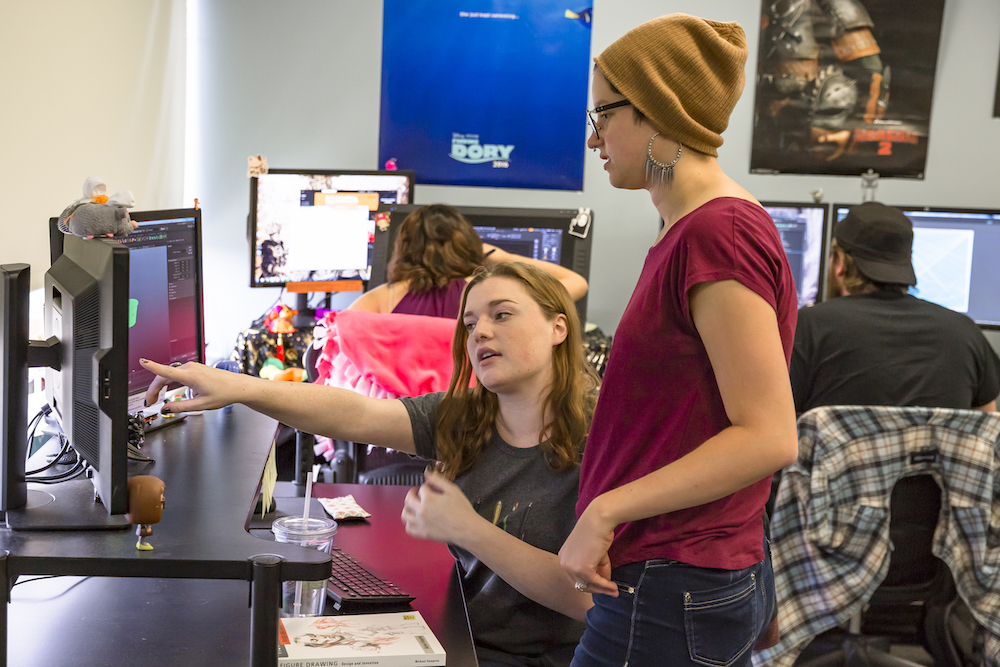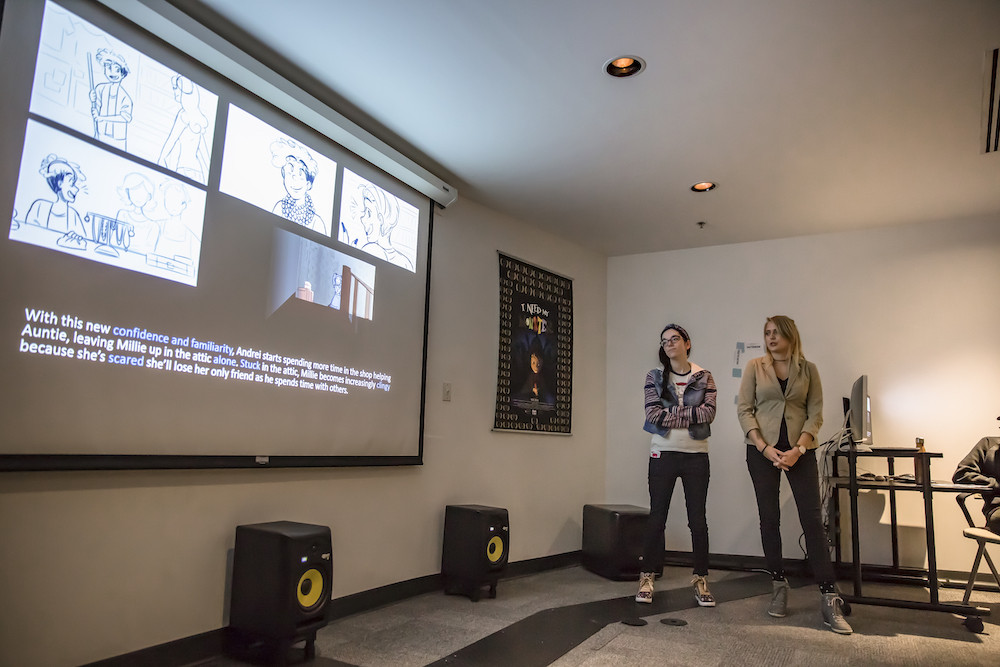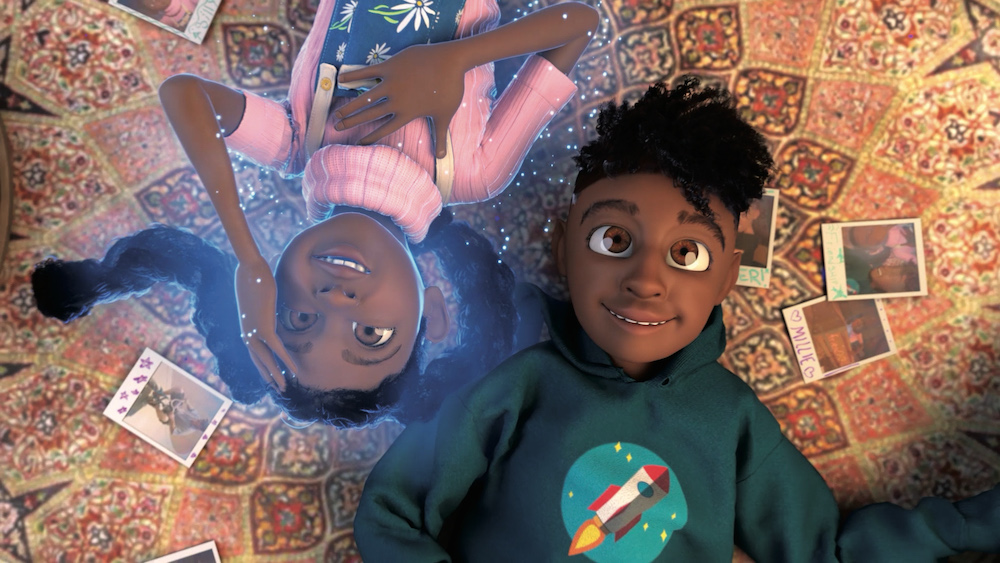Students Completing Their 3D Graphics & Animation Degree at CU Denver Benefit From Public-School Perks of a Nationally-Ranked Program
Between the state-of-the-art equipment, the knowledge of instructors connected to the animation industry, and the group-project dynamic of the curriculum, the Digital Animation Center at CU Denver is preparing a new generation of animators for the work force.
Animation is like woodworking. It’s very much a craft.
- Prof. Brett Rutland







When students enter the 3D Graphics & Animation degree program at CU Denver, the overwhelming feeling is that they are thrilled to have a seat at the table (or a rolling chair in the Design Animation Center, or DAC, as it were). The portfolio-based application for entry is daunting at first, especially when the professors who review your application have companies like Pixar and Sony Pictures on their respective resumes. But for those who dream about being on a team that produces the next Finding Nemo or Final Fantasy, earning a degree from Colorado’s highest-ranking animation program offered at a public school is incentive to pursue the program.
“Animation is like woodworking. It’s very much a craft,” Professor Matthew (Brett) Rutland says. “Students have to spend a lot of time with the characters and understanding how we in the industry approach the craft.”
The Benefits of Pursuing an Animation Degree at a Public University
In addition to gleaning the wisdom of industry experts, students in the 3D Graphics & Animation program also reap the benefits of attending a public institution. Many of the seniors in the capstone project groups are transfer students who came from a diverse background of schools. They were all attracted to CU Denver by the public-school price of the animation program compared to other, private art institutes and by the state-of-the-art computer labs.
In its 2022 rankings, the Animation Career Review placed CU Denver’s program in the top 15 percent of public schools and colleges in the U.S. offering animation degrees. This year’s ranking represents the seventh year CU Denver has been featured on the public school list. Taking into consideration academic reputation, admission selectivity, employment data, the depth and breadth of the program faculty, the value as it relates to tuition and indebtedness, and graduation rate, the ranking represents a reputable valuation of the animation degree CU Denver offers.
Student John Bailey appreciates the fact that because CU Denver is also a high-ranking public school offering degrees within multiple areas of studies, even his classes outside of CAM are taught by experts in their respective fields. CU Denver was also good about working with him to transfer credits for the previous course work he completed at Art Institute Colorado, a college that has since closed its doors. The accommodation of transfer credits, the affordable tuition, and the fact that the DAC has all the right equipment (like a render farm, for instance) is a big draw for all the students.
Hannah Meseck first saw the DAC while she was in high school and attending LYNX Camp at CU Denver. She had visited other “prestigious” art schools before attending the summer camp, but CU Denver was the first place where she not only saw a computer lab, but experienced the central role the labs play in a tech-forward area of study. Now a senior in the 3D Graphics & Animation program, Meseck describes with appreciation how Chris Lemon, lecturer and manager of the DAC, scrambled to get the students remote access to the computers when the pandemic caused in-person classes to come to an abrupt halt. Lemon was responsive to students’ (sometimes) panicked emails when glitches came up and problems needed to be solved, something all the students appreciated as they slogged through the year. Another student, Skyler, expressed appreciation for all the instructors, but particularly Ashley Hoffman, who had answered a question about an element of the capstone project, even though it had been a number of years since Skyler had been in Hoffman's classes.
Even though the pandemic made for a rough time, there were some silver linings. For instance, the program was able to employ instructors and lecturers who were previously inaccessible due to location. One such lecturer is Dan Finnegan, an animator based in Canada and whose VFX work can be seen on elements of the Star Wars franchise, the students share, eagerly.
Opportunities to work on such well-known projects are hard-won in what is increasingly becoming a very competitive industry. But several CAM alumni have broken through the barrier of entry and landed some pretty amazing positions. Jasmine Cisneros ’21 secured a position at Pixar after interning for the company while she was still a student at CU Denver. Two alum, Sabrina de La Garza ‘21 and Mason Marshall ’21, recently took positions at Moving Picture Company (MPC) in Canada. Faculty members emphasize the importance of having a stand-out demo reel in an effort to land these dream jobs and they work with the graduating seniors to identify the stand-out work they’ve done to compose such a reel.
Working on a Team: Learning the Skills Textbooks (or YouTube) Can’t Teach
By the time students get to the capstone project in their senior year of study, they have hours and hours of software training under their belts. Lower-level courses are focused on the basics of animation: Rigging, lighting, set and character design, storyboarding, and learning to use programs like Maya and Unreal. The capstone project is a massive undertaking in a group setting, where 5-10 students take everything they’ve learned to create an animated short (think the short stories that play before Pixar movies) from screenplay to finished product over the course of two semesters. The project has proven to be so much work that the instructors have adjusted the curriculum so subsequent students will begin it in their junior year instead.
The dynamics of working on a team come into play in this capstone project, and according to Instructor Jeremy Brown, are among the most important lessons students learn. Like many aspects of the carefully-crafted animation degree map, these lessons are offered with the dynamics of the animation industry in mind. Projects like feature-length films and even shorts are developed by massive teams, and animators don’t always get to choose who they work with. “I think all of us faculty members can say that whenever we speak to our colleagues in the industry about what they look for in new hires, they always say they want effective team-members before they look for raw skill or talent,” Brown says. To this end, a considerable amount of class time is spent collaborating with other students and professors, receiving “notes” on the projects they are working on (suggestions for improvement) and going back to the drawing board time and again until they get things just right.
Working on the capstone project requires students to stretch and develop skills they may not excel in. Bailey, who has been working in the aerospace industry for five years, says doing these non-dominate tasks will help them in the future, when they find themselves on larger teams where they will need to interact with or perhaps even direct teammates working on the same tasks they are trying to master now. “If you understand what needs to be done and have an idea how to do it, it helps you do your own job better,” Bailey reasons.
According to Brown, a digital compositor whose professional experience includes crafting visual effects (known as digital VFX) for everything from commercial advertisements to feature films, this interaction is exactly what the faculty members aim to facilitate. Sure, one could potentially learn the “hard” skills of using animation software via YouTube and independent study, but they wouldn’t learn the more vital “soft” skills needed when tackling a daunting project with a team of fellow animators.
If you ask Prof. Howard Cook, who has experience in both the aerospace and film industries, another major emphasis of the curriculum involves honing students’ storytelling skills. Cook utilizes lessons like Joseph Campbell’s hero cycle and Propp’s theory on characters. Then there are lessons on the nuances of storytelling from an eastern vs. western perspective and amplifying queer and other marginalized voices. The filmmaker’s job, says Cook, is to show versus tell, and a really good storyteller can do this using objects in a room, characterization, film angles, color schemes, lighting, etc. In animation especially, where entire worlds are crafted by set designers, students must learn how best to guide the viewer’s eye through the shot (what Cook likens to holding the viewer in a headlock). All the details of the set either add to or detract from the story, and they all need to serve a purpose. Then there are the dynamics of acting, which are not delivered by another person, as in live-action film, but by the work of the animators themselves. If this all sounds like a lot of things to consider, that’s because it is, and that’s why it takes so many people to create an animation.
Lots of Credit Hours and Lots of Work
If they were to offer advice to prospective students interested in animation, students finishing up their capstone say the following: “Be prepared to work hard”; “get some blue-light glasses”; “you have to be very dedicated and hard working to succeed.” In fact, the animation degree requires the most amount of credit hours compared to any other degree the College of Arts & Media (CAM) offers, and many students find they need five years instead of the typical four to complete the requirements for the program.
But it isn’t all hard work, sweat, and tears. During my visit to the DAC, I witnessed a “stand up” meeting, where instructors Brown and Paul Conner visited project groups to check on their progress and give notes. While sitting in a rolling chair, Conner zoomed around a table placed in the middle of the lab. “We have this table here because it’s like a racetrack,” Conner joked, presumably for my benefit, although the students got a chuckle out of his antics as well. Moments later he was high-fiving a student who had taken last week’s notes to heart and re-worked a character that looked much more realistic now, according to both instructors.
The students are working toward a deadline dictated by the college’s BFA spring theses exhibition. It’s something faculty and students look forward to every year as they get a chance to appreciate years of training and study that come together in one brilliant, oftentimes moving short animation. It is indeed the capstone of their experiences at CU Denver—something they can put on a resume as well as a reminder of all the lessons they learned in the DAC.
Written by Megan Briggs-Pintel, CAM Communications